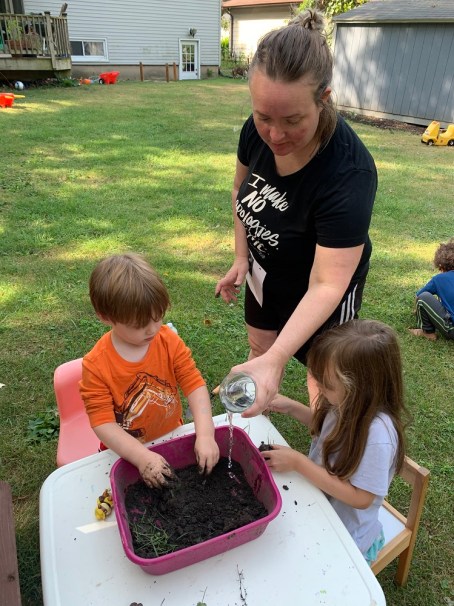As this school year started, I saw designated learning spaces in people’s homes everywhere I looked online. I’ll admit it: I was a bit in awe of all the organization. In our small house, my kids and I constantly shifted where we did our projects and work (and it’s constantly messy).
We may not have a dedicated school space, but here’s the thing I’ve realized: create a learning environment that works for you and your family. While I’ll always appreciate a good desk — my oldest has one in her room — I also love that we’re fostering learning in all sorts of ways in just about every room of our house.
(Affiliate links included).
Here is what has been working for us for encouraging learning at home, and I hope it helps you too.

Books, Books, Books Everywhere
Our house is overflowing with books. There are books in the living room, the dining area, the kids’ bedrooms, the basement, and even in the car. (I’ve been told some put books in the bathroom, but we’re just not there yet; my two young kids are, shall we say, just a bit too messy for that).
While our own personal library has expanded in recent months, we also have one shelf dedicated entirely to children’s books from the library. This constant rotation of books helps keep both the kids curious.
With books everywhere we look in our home learning environment, the kids are surrounded — literally — by stories and opportunities to learn. Some of my favorite moments in the day are when I see them pick up a book to flip through (and only one of our kids are officially reading).

Offer A Variety of Art Supplies
While I love planned projects (hello KiwiCo, which offers sets of activities and all the supplies you need), it’s also fun to see what kids come up with all on their own. Get an art supply cart (like this one) that you can roll around. Stock it with a variety of art supplies, such as construction paper, pipe cleaners, popsicle sticks, markers, stickers, googly eyes, glue sticks, and more.
Our current favorite open-ended art supply? Air dry modeling clay. It’s not nearly as messy as Playdough, and the kids often use it to make characters from the stories we read.

Keep Board Games On Hand
Play is a big part of our days, and board games are a huge part of our learning environment. In fact, I’m pretty sure they’re how my youngest learned his colors and numbers. Beyond teaching kids to count, they also teach them to play by the rules and take turns. (Read about our fav board games for preschoolers here).
Follow Their Lead and Teach Them How to Investigate
While we’re using a homeschool curriculum (Blossom & Root), BrainQuest workbooks, and Learning Dynamics for reading, I also pay attention to what my kids are interested in. For example, not too long ago we had a visit from one very large barn owl just before bedtime. The kids were in awe (and I was too). Cue the questions — oh so many questions.
I showed them how to look up the owls in our nature books. We checked out library books (nonfiction and fiction) about owls. I told them about how owls are awake at night, and we searched our yard for where he may be living in the trees.
To help their investigations, we have a whole lot of kid encyclopedias (thanks Usborne!) As they get older, I’ll also teach them more about how to do online searches.

Display Their Accomplishments
Positive reinforcement takes many forms. One way to offer positive reinforcement: installing a cork board to put up their favorite assignments or art work. This shows your child that you support them. It can also boost their self confidence. We regularly rotate what we display on our corkboard.
Take the Learning Outdoors
While we do some of our lessons and art projects at the kitchen table, we also head outside multiple times a day. I plan on continuing that routine even when the weather turns cold.

There’s something about the fresh air and change of scenery that often helps reset my kids’ moods (and, let’s be honest, my own). Plus, kids are natural explorers, and being outside, no surprise here, encourages a love of the outdoors.
The backyard may be outside the home, but it’s definitely a big part of our learning environment.
How have you designed your at-home learning environment? Do you have a dedicated space? I’d love to see or learn what you’ve done!
***
Don’t miss a blog post! Subscribe to Oops & Daisies here.


